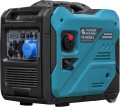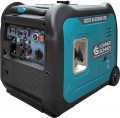Alternator winding
—
Copper. Copper winding is typical for advanced class generators. The copper alternator is characterized by high conductivity and low resistance. The conductivity of copper is 1.7 times higher than the conductivity of aluminium, such a winding heats up less, and compounds made of this metal endure temperature drops and vibration loads. Among the disadvantages of the copper winding, one can only note the high cost of the alternator. Otherwise, generators with copper winding have high reliability and durability.
— Aluminium. The aluminium winding of the alternator is typical for low-cost-class generators. The main advantages of aluminium are light weight and low price; otherwise, such a winding is usually inferior to copper counterparts. An oxide film is created on the surface of aluminium, it appears everywhere, even in the places of contact soldering. The oxide film undermines the contacts and does not allow the outer protective braid to securely hold the aluminium conductors.
Motor type
Model name of the engine installed in the generator. Knowing this name, you can, if necessary, find detailed data on the engine and clarify how it meets your requirements. In addition, model data may be needed for some specific tasks, including maintenance and repair.
Note that modern generators are often equipped with
branded engines from famous manufacturers: Honda, John Deere, Mitsubishi, Volvo, etc. Such engines are more expensive than similar units from little-known brands, but this is offset by higher quality and/or solid warranty conditions , and in many cases, the ease of finding spare parts and additional documentation (such as manuals for special maintenance and minor repairs).
Engine size
The working volume of the engine in a gasoline or diesel generator (see "Fuel"). Theoretically, more volume usually means more power, but in fact, everything is not so clear. Firstly, the specific power strongly depends on the type of fuel, and in gasoline units, also on the type of internal combustion engine (see above). Secondly, similar engines of the same power can have different volumes, and there is a practical point here: with the same power, a larger engine consumes more fuel, but by itself it can cost less.
Power
The operating power of the engine installed in the generator. Traditionally stated in horsepower; 1 HP approximately equal to 735 watts.
First of all, the rated power of the generator directly depends on this indicator (see above): in principle, it cannot be higher than the engine power, moreover, part of the engine power is spent on heat, friction and other losses. And the smaller the difference between these capacities, the higher the efficiency of the generator and the more economical it is. However high efficiency affects the cost, but this difference can pay off with regular use due to fuel savings.
Launch type
Method of starting an electric generator engine. To start an internal combustion engine (gasoline or diesel, see “Fuel”), in any case, it is necessary to rotate the engine shaft; you can do this in two ways:
-
Manual. With this starting method, the initial impulse is transmitted to the engine manually - usually the user needs to forcefully pull the cable that spins a special flywheel. The simplest in design and cheapest starting method, the additional equipment requires only the cable itself with a flywheel. On the other hand, it may require significant muscular effort from the user and is not well suited for high-power units.
—
Electric starter. With this type of starting, the engine shaft is rotated using a special electric motor, which is called a starter; The starter is powered by its own battery. This option for starting the generator power unit is the easiest for the user and requires a minimum of effort. Depending on the implementation of the electric starter, it is usually enough to turn the key in the ignition, press a button, turn a knob or spin a special drum, etc. The power of modern starters is sufficient even for heavy engines where manual starting is difficult or impossible. Also note that an electric starter is by definition required to use ATS autostart (see Features). On the other hand, additional equipment affects the weight and cost of the unit, sometimes quite notic
...eably. Therefore, such starting systems are used mainly where they cannot be avoided - in the aforementioned heavy equipment, as well as generators with ATS.Fuel consumption
Fuel consumption of a gasoline or diesel generator, and for combined models — when using gasoline (see "Fuel").
A more powerful engine inevitably means more fuel consumption; however, models with the same engine power may differ in this indicator. In such cases, it is worth considering that a model with a lower flow rate usually costs more, but this difference can quickly pay off, especially with regular use. In addition, knowing the fuel consumption and tank volume, you can determine how long one refueling will last; at the same time, in inverter models at partial load, the actual operating time may be noticeably higher than the theoretical one, see "Alternator" for details.
Fuel tank volume
The volume of the fuel tank installed in the generator.
Knowing the fuel consumption (see above) and the capacity of the tank, you can calculate the operating time on one gas station (if it is not indicated in the specifications). However, a more capacious tank is also more bulky. Therefore, manufacturers choose tanks based on the general level and "voracity" of the generator — in order to provide an acceptable operating time without a significant increase in size and weight. So in general, this parameter is more of a reference than practically significant.
As for the numbers, in low-power models, tanks are installed for
5 – 10 liters, or even
less ; in heavy professional equipment, this figure can
exceed 50 liters.
Continuous operation time
The time during which the generator is guaranteed to operate without interruption.
This parameter is indicated exclusively for liquid fuel models with a built-in tank, and according to the simplest formula: tank capacity divided by fuel consumption. However, in some models, data may be provided for a certain load level (which is specified in the notes); at a higher or lower load, the operating time will be shorter or longer, respectively. As for specific numbers, in most modern generators the operating time is
up to 8 hours - this is quite enough for backup power and occasional use. More reputable models are capable of working for
8 – 12 hours, and an indicator of
13 hours and above is typical mainly for professional solutions.
We also note that, theoretically, many generators can be refueled without shutting down, but in practice it is better to take breaks and not exceed the stated time of continuous operation - this will avoid overheating and increased wear.
Noise level
The noise level produced by the generator during normal operation. The less noise the unit makes, the more comfortable it is to use, the closer it can be placed to people, but the higher its price, all other things being equal.
It is also worth considering that generators with internal combustion engines are, in principle, quite noisy equipment. So, even the “quiest” units produce
up to 70 dB - this is the volume of conversation in tones from medium to high. Accordingly, it is recommended to install the device remotely from the place of use. At the same time, we note that the noise level is not directly related to power: for example, among units with 80 dB or more, there are both heavy and relatively low-power models.

